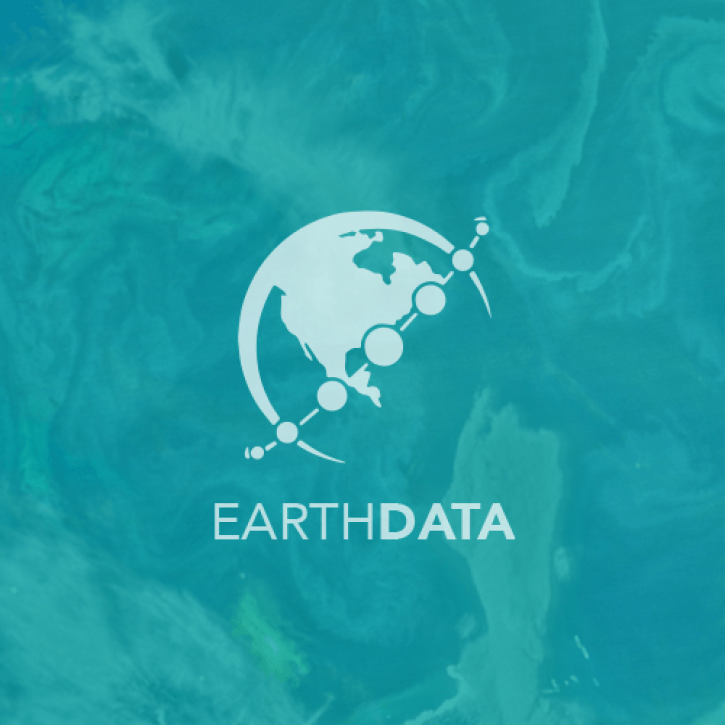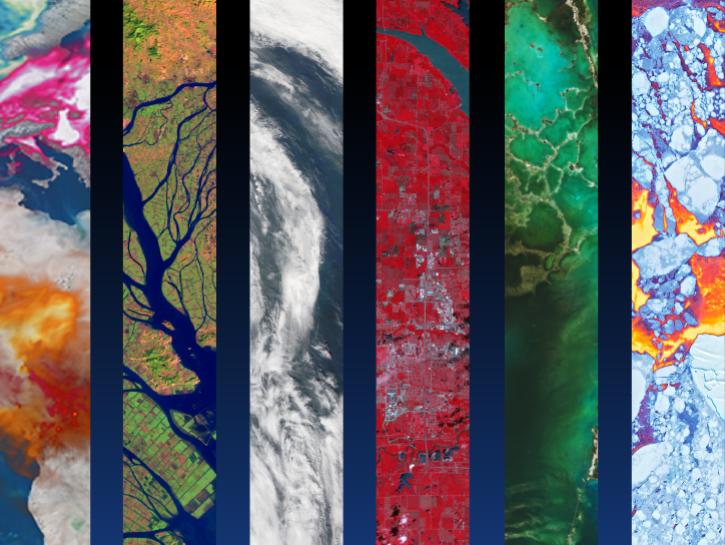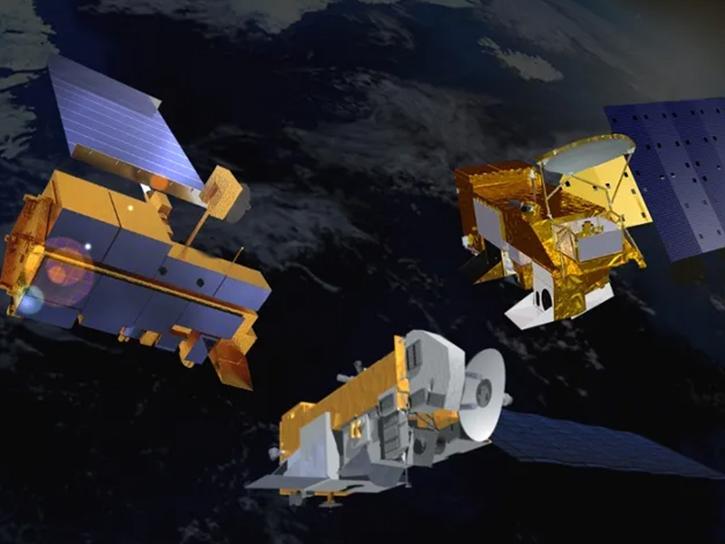We are in the process of migrating all NASA Earth science data sites into Earthdata from now until end of 2026. Not all NASA Earth science data and resources will appear here until then. Thank you for your patience as we make this transition.
Read about the Web Unification Project
Atmospheric Temperature Data Access and Tools
NASA has atmospheric temperature datasets that help researchers measure the degree of warmth in various levels of the atmosphere. Access a range of data and data tools such as AppEEARS, Worldview, and Giovanni to make the most of atmospheric temperature data.
Table of contents
Atmospheric Temperature Datasets
| Dataset | Platforms | Instruments | Temporal Extent | Location Keywords | Data Format |
|---|---|---|---|---|---|
| DISCOVER-AQ Colorado Deployment P-3B Aircraft In Situ Meteorological and Navigational Data | P-3B | DLH, GPS, PRESSURE TRANSDUCERS, TEMPERATURE SENSORS, HYGROMETERS | 2014-07-06 to 2014-08-14 | NORTH AMERICA, UNITED STATES OF AMERICA, COLORADO, NORTHERN HEMISPHERE, WESTERN HEMISPHERE | ICARTT |
| DISCOVER-AQ Colorado Deployment Table Mountain Ground Site Data | GROUND STATIONS | MULTIFILTER RADIOMETER, TEMPERATURE SENSORS, PRESSURE SENSORS | 2014-06-24 to 2014-08-13 | NORTH AMERICA, UNITED STATES OF AMERICA, COLORADO, WESTERN HEMISPHERE, NORTHERN HEMISPHERE | ICARTT |
| DISCOVER-AQ Maryland Deployment P-3B Aircraft In Situ Meteorological and Navigational Data | P-3B | DLH, GPS, PRESSURE TRANSDUCERS, TEMPERATURE SENSORS, HYGROMETERS | 2011-06-25 to 2011-08-02 | NORTH AMERICA, UNITED STATES OF AMERICA, DISTRICT OF COLUMBIA, MARYLAND, WESTERN HEMISPHERE | ICARTT |
| DISCOVER-AQ Maryland University of Maryland Cessna Aircraft Data | UMD Cessna | TECO 43C, TECO 49 | 2011-07-05 to 2011-08-02 | NORTH AMERICA, UNITED STATES OF AMERICA, DISTRICT OF COLUMBIA, MARYLAND, WESTERN HEMISPHERE | ICARTT |
| DISCOVER-AQ Texas Deployment Analysis and Ancillary Ground Site Data | GROUND STATIONS | CAPS NO2 Analyzer, 2B Technologies, PTR-MS, CEILOMETERS, Vaisala HUMICAP HMP155, RM Young 05103 Wind Monitor, TE525 Rain Gauge | 2013-08-13 to 2016-03-14 | NORTH AMERICA, UNITED STATES OF AMERICA, TEXAS, NORTHERN HEMISPHERE, WESTERN HEMISPHERE | ICARTT |
| DISCOVER-AQ Texas Deployment Moody Tower Ground Site Data | GROUND STATIONS | LIDAR, Thermo Model 49C O3 Analyzer, Thermo Scientific SO2 43i Analyzer, Thermo Scientific CO Analyzer, Thermo Model 42C NO-NO2-NOx Analyzer, Thermo Scientific NOx Analyzer, RM Young 05103 Wind Monitor, HMP45C Temperature and Relative Humidity Probe | 2013-08-30 to 2013-10-02 | NORTH AMERICA, UNITED STATES OF AMERICA, TEXAS, NORTHERN HEMISPHERE, WESTERN HEMISPHERE | HDF5, ICARTT |
| DISCOVER-AQ Texas Deployment P-3B Aircraft In Situ Meteorological and Navigational Data | P-3B | DLH, GPS, PRESSURE TRANSDUCERS, TEMPERATURE SENSORS, HYGROMETERS | 2013-08-26 to 2013-10-01 | NORTH AMERICA, UNITED STATES OF AMERICA, NORTHERN HEMISPHERE, WESTERN HEMISPHERE, TROPOSPHERE | ICARTT |
| DISCOVER-AQ Texas Deployment Smith Point Ground Site Data | GROUND STATIONS | MPL, 2B Technologies, 2B Technologies NO Monitor, 2B Technologies NO2 Converter, APS, TSI CPC-3010, MULTIFILTER RADIOMETER, CAPS NO2 Analyzer, TEMPERATURE SENSORS, PRESSURE SENSORS | 2013-08-27 to 2013-09-30 | NORTH AMERICA, UNITED STATES OF AMERICA, TEXAS, NORTHERN HEMISPHERE, WESTERN HEMISPHERE | HDF5, ICARTT |
| DISCOVER-AQ Texas Deployment Texas Commission on Environmental Quality Ground Site Data | GROUND STATIONS | GAS SENSORS, CHEMILUMINESCENCE, Teledyne API Model T200 NO/NO2/NOx Analyzer, Teledyne API Ozone Analyzer | 2013-08-13 to 2013-10-02 | NORTH AMERICA, UNITED STATES OF AMERICA, TEXAS, NORTHERN HEMISPHERE, WESTERN HEMISPHERE | ICARTT |
| Dynamics and Chemistry of the Summer Stratosphere Airborne Data Products | NASA ER-2, NCEP-GFS, ECMWF ERA5, GEOS-5 | MMS, UCATS-GC, DPOPS, ROZE, HWV, CANOE, CAFE, HAL, HUPCRS, Computer | 2021-06-09 to 2022-07-13 | CONTINENT, NORTH AMERICA, UNITED STATES OF AMERICA | ICARTT, NetCDF-4 |
Pagination
SHOWING 10 OF 1136
Featured Atmospheric Temperature Observation Method: MLS
The Microwave Limb Sounder (MLS) is radiometer and spectrometer that measures microwave thermal emission from the edge, or "limb," of Earth’s atmosphere. The MLS can measure vertical profiles of the atmosphere including temperature. The instrument acquires data globally day and night and can do so in the presence ice clouds and aerosols that would interfere with measurements from other devices.
In coordination with the Microwave Limb Sounder (MLS) team, we now have several MLS products available through the GIBS image access APIs.
Learn how to visualize Microwave Limb Sounder data through OPeNDAP.
The Microwave Limb Sounder Near-Real Time (MLS NRT) products are provided by the Land, Atmosphere Near-real time Capability for EOS (LANCE).
A new Request for Information (RFI) with responses due by April 4 seeks input for determining Terra, Aqua, and Aura mission data product continuity needs, capabilities, and gaps.
Frequently Asked Questions
Earthdata Forum
Our online forum provides a space for users to browse thousands of FAQs about research needs, data, and data applications. You can also submit new questions for our experts to answer.
Submit Questions to Earthdata Forumand View Expert Responses

